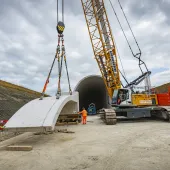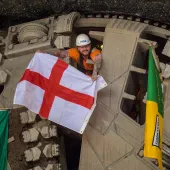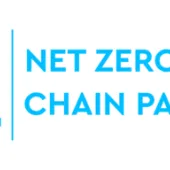Swedish concrete manufacturer unveil low-emission hybrid wall
Heidelberg Materials Precast Contiga and Metsä Wood have developed a hybrid wall element with a lower carbon footprint than conventional concrete wall elements.
The hybrid wall element is a facade panel with a sandwich construction, featuring an outer layer made of climate-improved concrete, intermediate insulation, and a load-bearing inner panel made of strong and material-efficient laminated veneer lumber, Kerto LVL.
The panel has approximately climate impact 30-50% lower when compared to an equivalent traditional concrete sandwich panel, and is significantly lighter, which also affects the overall climate impact of the entire construction project.
The hybrid wall element is particularly suitable for buildings with up to five floors.
These new hybrid wall panels are currently being tested on a real house that has been constructed at Precast Contiga's factory in Norrtälje and the building features moisture sensors to monitor what happens inside the wall elements, and to date, no moisture has been detected.
Daniel Eriksson, division manager at Heidelberg Materials Precast Contiga, said: “We are experiencing increased demands from our customers for environmentally smart solutions. The idea is that this serves as a great addition to our portfolio. Transportation to the construction site can be reduced because we can transport twice as many elements in the same shipment."
Precast Contiga manufacture steel frames and concrete elements in factories located in Norrtälje and Uddevalla, and nearly two years ago, the company began discussions with Metsä Wood to start manufacturing hybrid elements for the Swedish market.
“The production method is very similar to what we already have, so we can create these hybrid elements using the same approach as our other walls, and they are assembled in the same way. We haven’t made any major investments or modifications,” added Daniel.
“The European Union aims to be climate neutral by 2050, and the construction industry can contribute significantly to reach this target, and we’re experiencing a demand for climate-smart solutions from the construction industry. One of the advantages of this hybrid element is that construction contractors do not have to change their way of building with concrete elements, but can still lower their carbon dioxide emissions.
"At the same time, the walls can be made 50–75mm thinner than walls built with concrete elements, which can give quite a few extra square metres in a building”, explained Håkan Arnebrant, business development manager, Metsä Wood.







